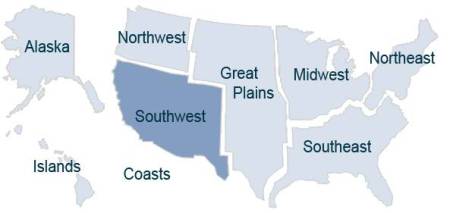Adapted from: Global Climate Impacts in the United States. T.R. Karl, J.M. Mellilo, and T.C. Peterson (eds.). Cambridge University Press, 2009. Available online at USGCRP Regional Climate Change Impacts
Recent warming in the Southwest has been among the most rapid in the nation, and it raises concerns about the region’s water sustainability. The warming is associated with declines in spring snowpack and Colorado River flow. Water supplies in some areas are already becoming limited. Conflict over water rights is likely to continue and worsen. The prospect of future droughts becoming more severe due to warming is a significant concern, especially because the Southwest continues to lead the nation in population growth.
Projections of future climate change indicate continued strong warming in the region, with much larger increases under scenarios of higher emissions of greenhouse gases. Projected summertime temperature increases are greater than the annual average increases in parts of the region and are likely to be exacerbated by expanding urban heat island effects. Further water cycle changes are projected. Combined with increasing temperatures and rising demand for water as population grows, these changes signal a serious water supply challenge in the decades and centuries ahead.
Key issues include:
- Water supplies are likely to become increasingly scarce. Global Climate Models project reductions in spring precipitation for the Southwest, with increased aridity likely to occur throughout the year as evaporation rates rise with temperature. Water is vital to agriculture, hydroelectric power production, the growing human population, and ecosystems. Continued temperature increases combined with river flow reductions and rapid population growth will increase competition for water supplies and require trade-offs among competing uses.
- The landscape will be transformed by increasing temperature, drought, wildfire, and invasive species. Impacts of climate change on the landscape of the Southwest are likely to be substantial, threatening biological diversity, protected areas, and ranching and agricultural lands. Temperature increases have made the current drought in the region more severe than previous droughts of the last several centuries. Record-setting wildfires are resulting from the rising temperatures and related reductions in spring snowpack and soil moisture. Invasive grasses are disrupting the ecological balance and increasing the fire hazard in some areas.
- More floods will increase risks to people, ecosystems, and infrastructure. Increased frequency and altered timing of flooding is likely to lead to increased risks in cities, on roads, and in forests and other ecosystems. Rapid landscape transformation due to vegetation die-off, wildfire, and loss of wetlands along rivers could further reduce flood-buffering capacity. The increased fraction of winter precipitation falling as rain instead of snow also increases flood risk because rain can reach rivers more rapidly.
- Unique tourism and recreation opportunities are likely to suffer. Rising temperatures will adversely affect winter activities such as downhill and cross-country skiing, snowshoeing, and snowmobiling. Later snow and less snow coverage are projected for ski resort areas, particularly those in the southern part of the region. Under scenarios of higher greenhouse gas emissions, decreases in end-of-season snow cover of between 40 to nearly 90 percent are likely in counties with major ski resorts from New Mexico to California.
- Cities and agriculture face increasing risks from a changing climate. With more intense, longer-lasting heat waves projected to occur over this century, demands for air conditioning are expected to deplete electricity supplies, increasing risks of brownouts and blackouts. Much of the region’s agriculture will experience detrimental impacts in a warmer future. Particularly at risk are specialty crops in California such as apricots, almonds, artichokes, figs, kiwis, olives, and walnuts. These and other such crops require a minimum number of hours below a chilling temperature threshold in the winter to set fruit for the following year.
Adapted by Melanie Lenart, University of Arizona
External Links:
Climate Assessment for the Southwest
Related Pages:
The North American Monsoon System
USGS Study on Desert Species Abundance and Climate Change
Other Regional Climate Change Impacts from USGCRP:
- Northeast U.S.
- Southeast U.S.
- Midwest
- Great Plains
- Northwest U.S.
- Alaska
- Pacific Islands and the Caribbean
- Coastal United States

